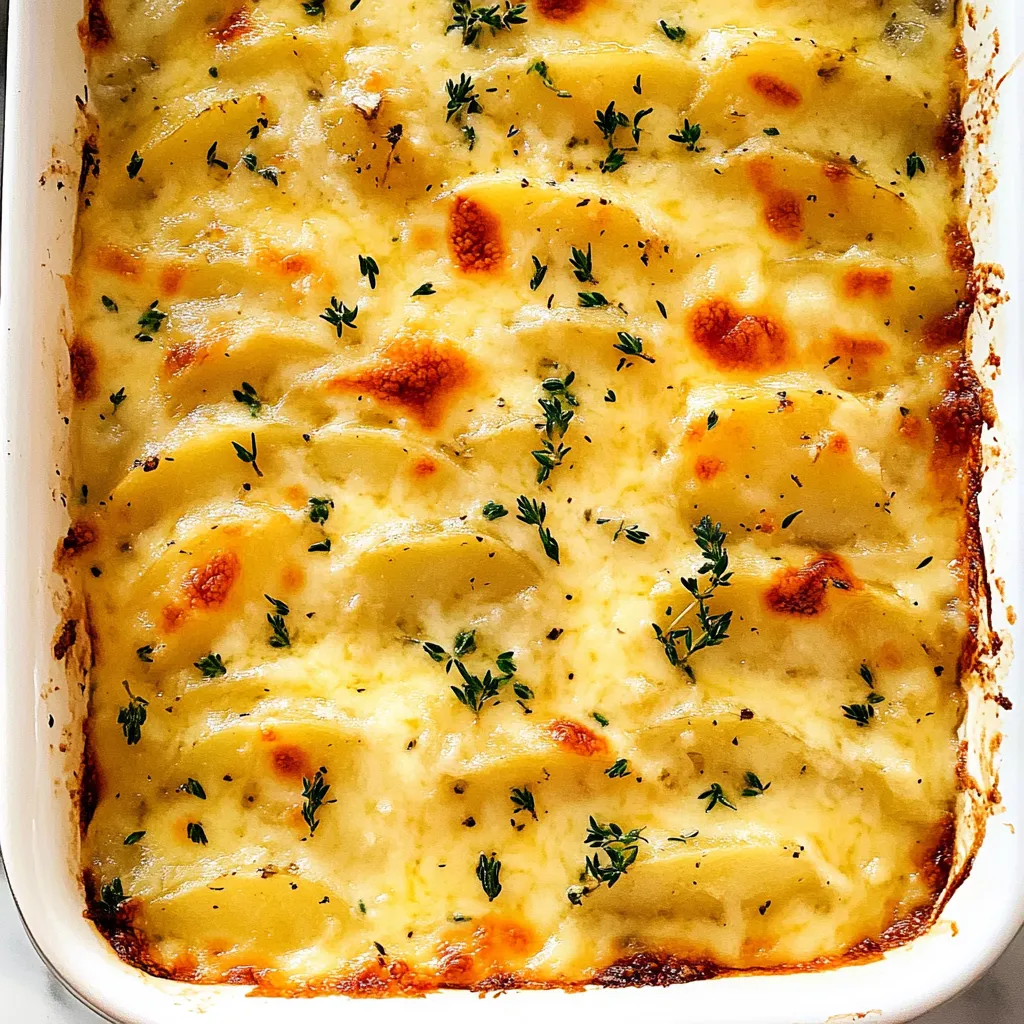 Pin it
Pin it
The comforting allure of perfectly creamy, cheesy scalloped potatoes transforms any meal from ordinary to memorable. These aren't just any scalloped potatoes—they're mouthwateringly rich, infused with garlic and fresh thyme, and blanketed in golden, bubbly cheese that creates those coveted crispy edges. Whether gracing your Easter table or accompanying a simple weeknight dinner, this tried-and-true recipe delivers restaurant-quality results that have earned thousands of devoted fans.
I first made these scalloped potatoes for a family gathering where opinions on the "perfect" version vary wildly. To my surprise, both my cream-loving aunt and my cheese-devoted cousin reached for seconds, and my brother-in-law who "doesn't like scalloped potatoes" cleared his plate. These potatoes seem to have that magical quality of pleasing everyone around the table!
Ingredients That Make All The Difference
- Yukon gold potatoes: Their naturally buttery flavor and waxy texture hold shape while becoming perfectly tender. The creamy consistency creates a luxurious mouthfeel that russets simply can't match.
- Sharp cheddar cheese: Provides the perfect balance of flavor and meltability. Aged cheddars have wonderful flavor but don't melt as smoothly, so choose a younger sharp cheddar for best results.
- Fresh thyme: Brightens the rich sauce with subtle herbal notes that complement the potatoes perfectly. The aromatic quality adds complexity that dried herbs can't quite achieve.
- Combination of milk and stock: Using chicken stock alongside milk creates depth of flavor while keeping the sauce from becoming too heavy. This balanced approach yields a sauce that's rich yet not overwhelming.
- Roux base: Starting with butter and flour creates a silky, stable sauce that won't separate during baking, unlike recipes that rely solely on heavy cream.
Step-by-Step Instructions
- Step 1:
- Begin by preparing your potatoes properly. Wash them thoroughly and peel if desired, though I often leave the skins on for added texture and nutritional value. Using a sharp knife or mandoline, slice the potatoes into uniform 1/4-inch thick rounds. Consistency in thickness is crucial for even cooking—thicker slices will remain firm while thinner ones might overcook. Place the sliced potatoes in cold water temporarily if not using immediately to prevent discoloration.
- Step 2:
- Create your cream sauce by melting butter in a large saucepan over medium heat. Add the thinly sliced onions and sauté for about 4-5 minutes until softened and translucent but not browned. Add the minced garlic and cook for another 30-60 seconds until fragrant. The gentle cooking releases the aromatics without developing bitter notes that can come from overcooked garlic.
- Step 3:
- Sprinkle the flour over the onion-garlic mixture and stir continuously for about 1 minute to form a roux. This critical step cooks out the raw flour taste while creating the thickening base for your sauce. The mixture should look like a thick paste and smell slightly nutty as the flour toasts lightly.
- Step 4:
- Gradually add the chicken stock while whisking constantly to prevent lumps from forming. Once incorporated, slowly pour in the milk, continuing to whisk. This gradual approach ensures a smooth sauce without flour lumps. Season with salt, pepper, and fresh thyme leaves. Bring the mixture to a gentle simmer, watching carefully and stirring frequently to prevent scorching on the bottom of the pan.
- Step 5:
- Once the sauce slightly thickens (it will continue to thicken in the oven), remove it from heat. Do not let it boil vigorously as this can cause the sauce to break and become grainy when baked. Strain the sauce if you prefer not having onion pieces in the final dish, reserving the strained onions to add between potato layers.
- Step 6:
- Prepare your baking dish by greasing a 9×13 inch casserole with butter or cooking spray. Begin layering by arranging half of the sliced potatoes in an overlapping pattern on the bottom of the dish. This creates a solid foundation and ensures every bite contains perfectly sauced potato.
- Step 7:
- Pour half of the cream sauce over the first layer of potatoes, spreading evenly to ensure complete coverage. If you've strained the onions out, distribute them across this layer now. Sprinkle with half of the shredded cheddar (1 cup) and all of the Parmesan cheese, which adds a sharp, salty note that complements the creamy sauce perfectly.
- Step 8:
- Create the second layer with the remaining potato slices, arranging them neatly. Pour the remaining sauce over the top, ensuring it seeps down between the potato slices. This complete coverage is essential for proper cooking and creating that creamy texture throughout. Finish by sprinkling the remaining cup of cheddar cheese evenly across the top.
- Step 9:
- Cover the dish loosely with aluminum foil and bake in a preheated 350°F oven for 30-35 minutes. The foil prevents the cheese from browning too quickly before the potatoes are tender. After this initial baking period, remove the foil and continue baking for an additional 25-30 minutes until the potatoes are easily pierced with a knife and the top is beautifully golden and bubbling. If the top begins to brown too quickly, lightly recover with foil while the potatoes finish cooking.
 Pin it
Pin it
I discovered the importance of the milk-stock combination through pure kitchen serendipity. Running short on milk one holiday, I substituted some chicken stock and was amazed at how it enhanced the overall flavor compared to my traditional all-dairy version. The slight savory note from the stock balanced the richness perfectly, and I've never gone back to the heavy cream-only approach.
Magnificent Variations
The versatility of this recipe is part of its enduring appeal. For a heartier main dish, add layers of diced ham or crumbled bacon between the potatoes. Vegetable additions like sautéed mushrooms, wilted spinach, or caramelized leeks create delicious complexity. For cheese adventurers, try swapping half the cheddar for smoked gouda or nutty gruyère. A Southwest version with green chiles and pepper jack cheese transforms the dish entirely while maintaining its comforting appeal.
Make-Ahead Magic
Holiday meal preparation becomes significantly less stressful when you know these potatoes can be completely prepared up to three days in advance. After baking, cool them completely at room temperature, then cover tightly and refrigerate. On serving day, let the dish sit at room temperature for 30 minutes before baking, covered with foil, at 350°F for about 30 minutes until heated through. Remove the foil for the last 5-10 minutes to re-crisp the top if desired.
Perfect Pairings
These scalloped potatoes complement nearly any protein beautifully. They're particularly wonderful alongside a spiral-cut ham, herb-roasted chicken, or beef tenderloin. For lighter fare, serve with a crisp green salad dressed with a tart vinaigrette to balance the richness. A side of simply prepared green vegetables like roasted asparagus or steamed green beans provides welcome color and textural contrast.
I've come to treasure this scalloped potato recipe not just for its incredible flavor, but for the way it brings people together around the table. There's something deeply satisfying about watching faces light up at the sight of that bubbling, golden casserole emerging from the oven. Whether it's the centerpiece of your Easter spread or the comforting side to a regular Tuesday dinner, these potatoes have a way of transforming any meal into something special—proving that sometimes the simplest foods, when prepared with care, create the most lasting memories.
Frequently Asked Questions
- → Can I make scalloped potatoes ahead of time?
- Yes! Assemble the dish, cover with foil and refrigerate for up to 24 hours. Add 10-15 minutes to the covered baking time when cooking from cold.
- → What's the difference between scalloped potatoes and au gratin?
- Traditional scalloped potatoes don't include cheese, while au gratin potatoes do. This recipe is technically a hybrid since it includes cheese.
- → Can I freeze these scalloped potatoes?
- Yes, but the texture might change slightly. Bake completely, cool, wrap tightly and freeze. Thaw overnight before reheating covered at 350°F until hot throughout.
- → What potatoes work best for scalloped potatoes?
- Yukon Gold potatoes are ideal because they hold their shape while becoming creamy. Russets work too but tend to break down more.
- → Can I make this recipe without dairy?
- You can substitute plant-based butter, milk and cheese, but the flavor and texture will differ from the original recipe.
